Indigenous Knowledge and Epistemology: An Australian Study
VerifiedAdded on 2023/01/11
|8
|2142
|48
Essay
AI Summary
This essay delves into the realm of Indigenous knowledge and epistemology within the Australian context, exploring the perspectives of Indigenous academics and contrasting them with Western viewpoints. It begins by highlighting Australia's historical cultural confluence, emphasizing the rich traditions of Aboriginal and Torres Strait Islander peoples. The essay examines the unique relationship Indigenous cultures have with nature and their community-oriented values. It analyzes how Western societies have sometimes sought to reframe Indigenous knowledge and the challenges that arise from these interactions. The literature review explores the variations in knowledge sharing among different Indigenous tribes, gender biases, and the importance of identity. The essay concludes by emphasizing the need for governmental efforts to uplift Indigenous communities, promoting education, and encouraging cultural understanding to create a more inclusive society.
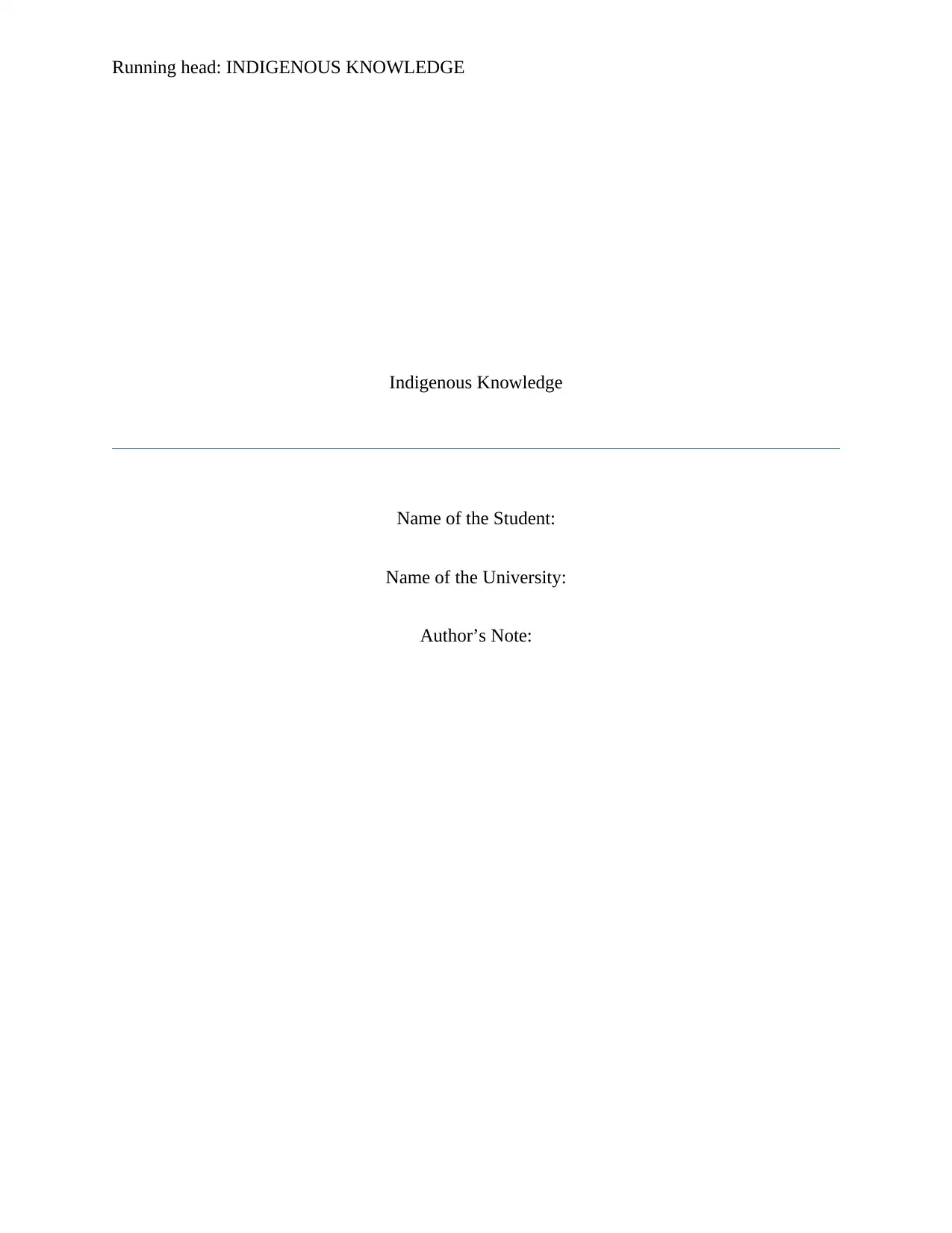
Running head: INDIGENOUS KNOWLEDGE
Indigenous Knowledge
Name of the Student:
Name of the University:
Author’s Note:
Indigenous Knowledge
Name of the Student:
Name of the University:
Author’s Note:
Paraphrase This Document
Need a fresh take? Get an instant paraphrase of this document with our AI Paraphraser
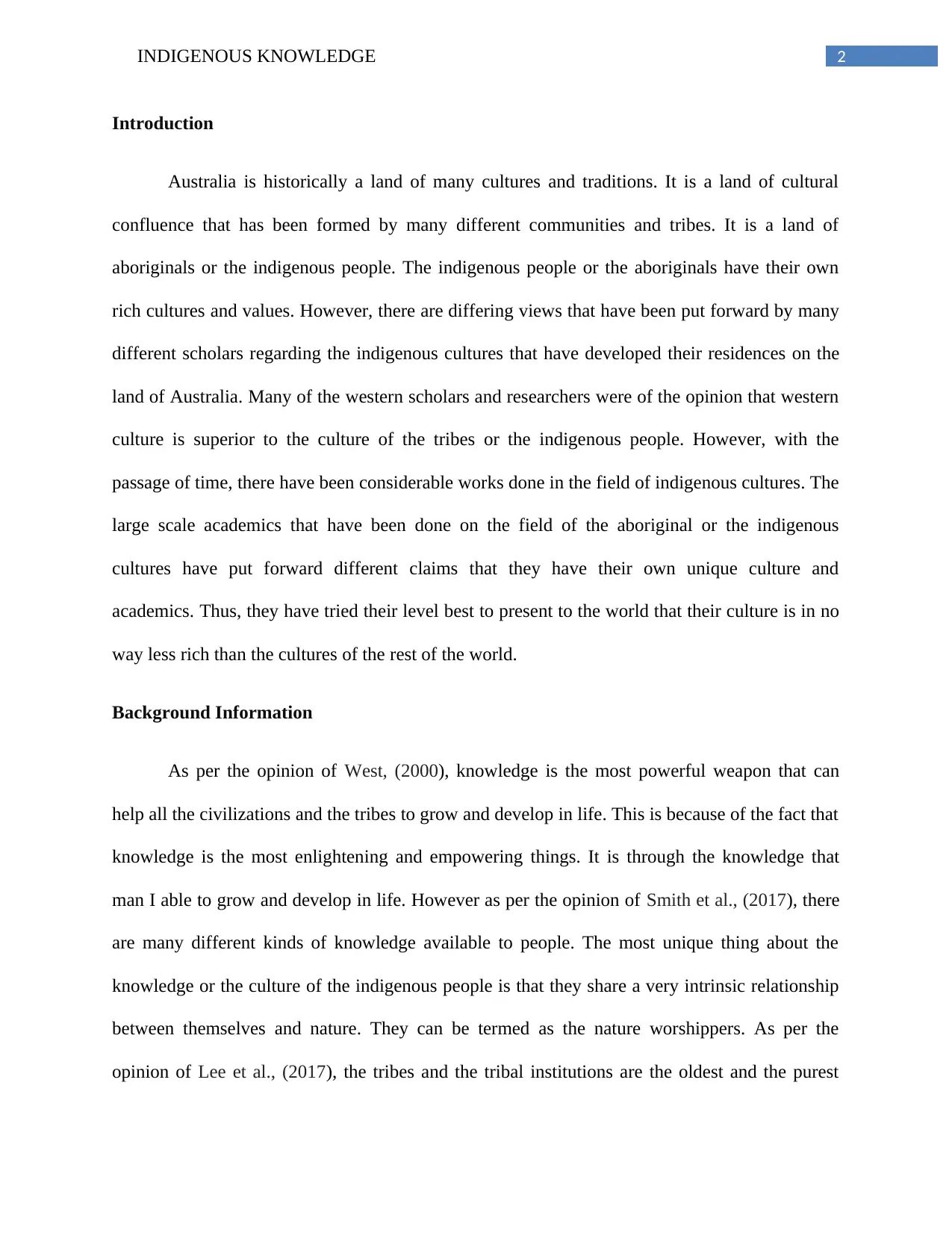
2INDIGENOUS KNOWLEDGE
Introduction
Australia is historically a land of many cultures and traditions. It is a land of cultural
confluence that has been formed by many different communities and tribes. It is a land of
aboriginals or the indigenous people. The indigenous people or the aboriginals have their own
rich cultures and values. However, there are differing views that have been put forward by many
different scholars regarding the indigenous cultures that have developed their residences on the
land of Australia. Many of the western scholars and researchers were of the opinion that western
culture is superior to the culture of the tribes or the indigenous people. However, with the
passage of time, there have been considerable works done in the field of indigenous cultures. The
large scale academics that have been done on the field of the aboriginal or the indigenous
cultures have put forward different claims that they have their own unique culture and
academics. Thus, they have tried their level best to present to the world that their culture is in no
way less rich than the cultures of the rest of the world.
Background Information
As per the opinion of West, (2000), knowledge is the most powerful weapon that can
help all the civilizations and the tribes to grow and develop in life. This is because of the fact that
knowledge is the most enlightening and empowering things. It is through the knowledge that
man I able to grow and develop in life. However as per the opinion of Smith et al., (2017), there
are many different kinds of knowledge available to people. The most unique thing about the
knowledge or the culture of the indigenous people is that they share a very intrinsic relationship
between themselves and nature. They can be termed as the nature worshippers. As per the
opinion of Lee et al., (2017), the tribes and the tribal institutions are the oldest and the purest
Introduction
Australia is historically a land of many cultures and traditions. It is a land of cultural
confluence that has been formed by many different communities and tribes. It is a land of
aboriginals or the indigenous people. The indigenous people or the aboriginals have their own
rich cultures and values. However, there are differing views that have been put forward by many
different scholars regarding the indigenous cultures that have developed their residences on the
land of Australia. Many of the western scholars and researchers were of the opinion that western
culture is superior to the culture of the tribes or the indigenous people. However, with the
passage of time, there have been considerable works done in the field of indigenous cultures. The
large scale academics that have been done on the field of the aboriginal or the indigenous
cultures have put forward different claims that they have their own unique culture and
academics. Thus, they have tried their level best to present to the world that their culture is in no
way less rich than the cultures of the rest of the world.
Background Information
As per the opinion of West, (2000), knowledge is the most powerful weapon that can
help all the civilizations and the tribes to grow and develop in life. This is because of the fact that
knowledge is the most enlightening and empowering things. It is through the knowledge that
man I able to grow and develop in life. However as per the opinion of Smith et al., (2017), there
are many different kinds of knowledge available to people. The most unique thing about the
knowledge or the culture of the indigenous people is that they share a very intrinsic relationship
between themselves and nature. They can be termed as the nature worshippers. As per the
opinion of Lee et al., (2017), the tribes and the tribal institutions are the oldest and the purest

3INDIGENOUS KNOWLEDGE
forms of social institutions that are available for man. It is the largest forms of social technology
that is available for man.
The most unique feature about this culture is that the aboriginals or indigenous people are
capable of retaining their values constantan over the years. At the same time, they make sure that
they are being able to adjust to the new changes and the innovations that are taking place around
them. As per the opinion of Mayer (2015), the indigenous people have rue values and they
believe in collaborative couture. As a result, of this, their culture is not properly oriented but
people oriented. They believe that decisions are to be taken in a most successful manner. They
have to understand that one of the major aspects of the aboriginal culture is to make sure that the
community as a whole is being benefitted from them. The aboriginal culture is not selfish in
nature rather they try to form a close connection with all their community members. It must be
noted in this context that one of the major aspects of the indigenous couture is their quick
response to the different events taking place around them and the way they convey their
response. The people belonging from the tribes and the indigenous culture make sure that they
are being highly accountable for any kinds of issues that are taking place within their
community.
Western societies for their own reasons have sought to re-cast the concepts, the spirit and the
frameworks of Indigenous First Knowledge by demanding that any such knowledge offered or
explored in their space and time be drawn under parallelisms
The above-mentioned lines are evident of the fact that the western people have often
tried to remove much of the essential aspects of the tribes for their own benefits West, E. G.
forms of social institutions that are available for man. It is the largest forms of social technology
that is available for man.
The most unique feature about this culture is that the aboriginals or indigenous people are
capable of retaining their values constantan over the years. At the same time, they make sure that
they are being able to adjust to the new changes and the innovations that are taking place around
them. As per the opinion of Mayer (2015), the indigenous people have rue values and they
believe in collaborative couture. As a result, of this, their culture is not properly oriented but
people oriented. They believe that decisions are to be taken in a most successful manner. They
have to understand that one of the major aspects of the aboriginal culture is to make sure that the
community as a whole is being benefitted from them. The aboriginal culture is not selfish in
nature rather they try to form a close connection with all their community members. It must be
noted in this context that one of the major aspects of the indigenous couture is their quick
response to the different events taking place around them and the way they convey their
response. The people belonging from the tribes and the indigenous culture make sure that they
are being highly accountable for any kinds of issues that are taking place within their
community.
Western societies for their own reasons have sought to re-cast the concepts, the spirit and the
frameworks of Indigenous First Knowledge by demanding that any such knowledge offered or
explored in their space and time be drawn under parallelisms
The above-mentioned lines are evident of the fact that the western people have often
tried to remove much of the essential aspects of the tribes for their own benefits West, E. G.
⊘ This is a preview!⊘
Do you want full access?
Subscribe today to unlock all pages.

Trusted by 1+ million students worldwide

4INDIGENOUS KNOWLEDGE
(2000). The western people have often tried to make the aboriginal cultures devoid of the most
essential elements like the air, water soil and the other aspects of nature for making the literature
simpler for themselves. However, it must be noted in this context that this art of objectifying the
most crucial elements of the indigenous culture is because of their attempts to find out some
explicit symbols that would match up with the westernized minds.
As per the opinion of Bullen & Flavell (2017), the aboriginal culture is in favor of
personifying the knowledge. Knowledge is one of the most important aspects of the features of
the aboriginal culture. However, there are some even among the people belonging from the
indigenous cultures. The Yolngu culture for an instant view of knowledge as something different
and something closed. They have not seen knowledge as something very open or something that
can be under the willpower of anyone and everyone. The teachers who are teaching these
students have to keep in mind that the couture from which these students are coming are of a
totally different nature. They have always been away from learning and knowledge. Thus their
ways of understanding different contexts will be varying from the other people.
Review of Literature
As per the opinion of Bodkin-Andrews & Carlson (2016), there are also several
variations in the people of the indigenous tribes. The custom through which the knowledge is
shared among the people of the indigenous tribe is not the same. There are several variations that
have been seen among the people belonging from different tribes. There are great variations in
the way or the method in which the knowledge has been floated down among them. It is only
through knowledge that the indigenous people have been capable of living and have been able to
make some attempts to develop a proper identity of their own. It is for this reason that the
(2000). The western people have often tried to make the aboriginal cultures devoid of the most
essential elements like the air, water soil and the other aspects of nature for making the literature
simpler for themselves. However, it must be noted in this context that this art of objectifying the
most crucial elements of the indigenous culture is because of their attempts to find out some
explicit symbols that would match up with the westernized minds.
As per the opinion of Bullen & Flavell (2017), the aboriginal culture is in favor of
personifying the knowledge. Knowledge is one of the most important aspects of the features of
the aboriginal culture. However, there are some even among the people belonging from the
indigenous cultures. The Yolngu culture for an instant view of knowledge as something different
and something closed. They have not seen knowledge as something very open or something that
can be under the willpower of anyone and everyone. The teachers who are teaching these
students have to keep in mind that the couture from which these students are coming are of a
totally different nature. They have always been away from learning and knowledge. Thus their
ways of understanding different contexts will be varying from the other people.
Review of Literature
As per the opinion of Bodkin-Andrews & Carlson (2016), there are also several
variations in the people of the indigenous tribes. The custom through which the knowledge is
shared among the people of the indigenous tribe is not the same. There are several variations that
have been seen among the people belonging from different tribes. There are great variations in
the way or the method in which the knowledge has been floated down among them. It is only
through knowledge that the indigenous people have been capable of living and have been able to
make some attempts to develop a proper identity of their own. It is for this reason that the
Paraphrase This Document
Need a fresh take? Get an instant paraphrase of this document with our AI Paraphraser
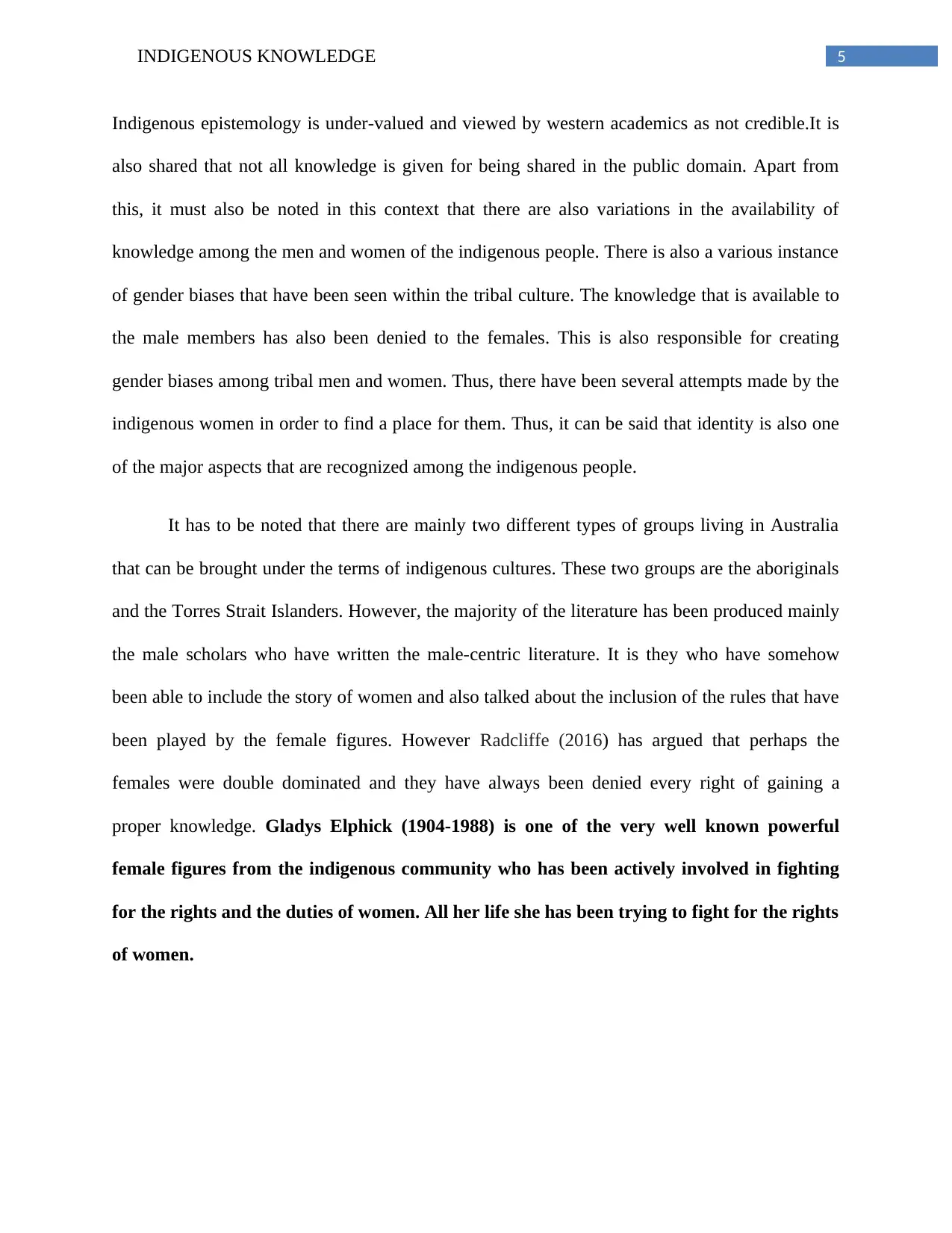
5INDIGENOUS KNOWLEDGE
Indigenous epistemology is under-valued and viewed by western academics as not credible.It is
also shared that not all knowledge is given for being shared in the public domain. Apart from
this, it must also be noted in this context that there are also variations in the availability of
knowledge among the men and women of the indigenous people. There is also a various instance
of gender biases that have been seen within the tribal culture. The knowledge that is available to
the male members has also been denied to the females. This is also responsible for creating
gender biases among tribal men and women. Thus, there have been several attempts made by the
indigenous women in order to find a place for them. Thus, it can be said that identity is also one
of the major aspects that are recognized among the indigenous people.
It has to be noted that there are mainly two different types of groups living in Australia
that can be brought under the terms of indigenous cultures. These two groups are the aboriginals
and the Torres Strait Islanders. However, the majority of the literature has been produced mainly
the male scholars who have written the male-centric literature. It is they who have somehow
been able to include the story of women and also talked about the inclusion of the rules that have
been played by the female figures. However Radcliffe (2016) has argued that perhaps the
females were double dominated and they have always been denied every right of gaining a
proper knowledge. Gladys Elphick (1904-1988) is one of the very well known powerful
female figures from the indigenous community who has been actively involved in fighting
for the rights and the duties of women. All her life she has been trying to fight for the rights
of women.
Indigenous epistemology is under-valued and viewed by western academics as not credible.It is
also shared that not all knowledge is given for being shared in the public domain. Apart from
this, it must also be noted in this context that there are also variations in the availability of
knowledge among the men and women of the indigenous people. There is also a various instance
of gender biases that have been seen within the tribal culture. The knowledge that is available to
the male members has also been denied to the females. This is also responsible for creating
gender biases among tribal men and women. Thus, there have been several attempts made by the
indigenous women in order to find a place for them. Thus, it can be said that identity is also one
of the major aspects that are recognized among the indigenous people.
It has to be noted that there are mainly two different types of groups living in Australia
that can be brought under the terms of indigenous cultures. These two groups are the aboriginals
and the Torres Strait Islanders. However, the majority of the literature has been produced mainly
the male scholars who have written the male-centric literature. It is they who have somehow
been able to include the story of women and also talked about the inclusion of the rules that have
been played by the female figures. However Radcliffe (2016) has argued that perhaps the
females were double dominated and they have always been denied every right of gaining a
proper knowledge. Gladys Elphick (1904-1988) is one of the very well known powerful
female figures from the indigenous community who has been actively involved in fighting
for the rights and the duties of women. All her life she has been trying to fight for the rights
of women.

6INDIGENOUS KNOWLEDGE
Discussion
There are two different groups of tribes known in Australia namely the Aboriginal
and the Torres Strait Islander people, two different cultures. The Torres Strait Islanders are
people who mainly occupy the island whereas the Aboriginals are people who live scattered over
the mainland of Australia and whereas the top parts of the islands are occupied by the Torres
Strait people. They have differences in their culture and also it is reflected through their art and
architecture as well.
Conclusion
Thus it can be concluded that it is the duty of the Government to take due efforts in order
to upgrade the Indigenous people. The tribes have to be brought from the margins into the center.
Most of the negligence is caused due to illiteracy and awareness. Majority of the parents of these
communities are too timid to bring themselves and their children to the forefront. As a result of
this, the development is still in its stage of infancy. Efforts are to be made so that more and more
people from the indigenous background are brought into the limelight so that they can get
educated. However, there will naturally be several challenges between the western and the
indigenous cultures. The major motif of the Government must be to implement rules and laws
that would safeguard the interests of these indigenous [people and encourage them to come into
the center. All the citizens must be encouraged and motivated to learn from each other and work
together. This will lead to the successful formation of a cultural confluence.
Discussion
There are two different groups of tribes known in Australia namely the Aboriginal
and the Torres Strait Islander people, two different cultures. The Torres Strait Islanders are
people who mainly occupy the island whereas the Aboriginals are people who live scattered over
the mainland of Australia and whereas the top parts of the islands are occupied by the Torres
Strait people. They have differences in their culture and also it is reflected through their art and
architecture as well.
Conclusion
Thus it can be concluded that it is the duty of the Government to take due efforts in order
to upgrade the Indigenous people. The tribes have to be brought from the margins into the center.
Most of the negligence is caused due to illiteracy and awareness. Majority of the parents of these
communities are too timid to bring themselves and their children to the forefront. As a result of
this, the development is still in its stage of infancy. Efforts are to be made so that more and more
people from the indigenous background are brought into the limelight so that they can get
educated. However, there will naturally be several challenges between the western and the
indigenous cultures. The major motif of the Government must be to implement rules and laws
that would safeguard the interests of these indigenous [people and encourage them to come into
the center. All the citizens must be encouraged and motivated to learn from each other and work
together. This will lead to the successful formation of a cultural confluence.
⊘ This is a preview!⊘
Do you want full access?
Subscribe today to unlock all pages.

Trusted by 1+ million students worldwide
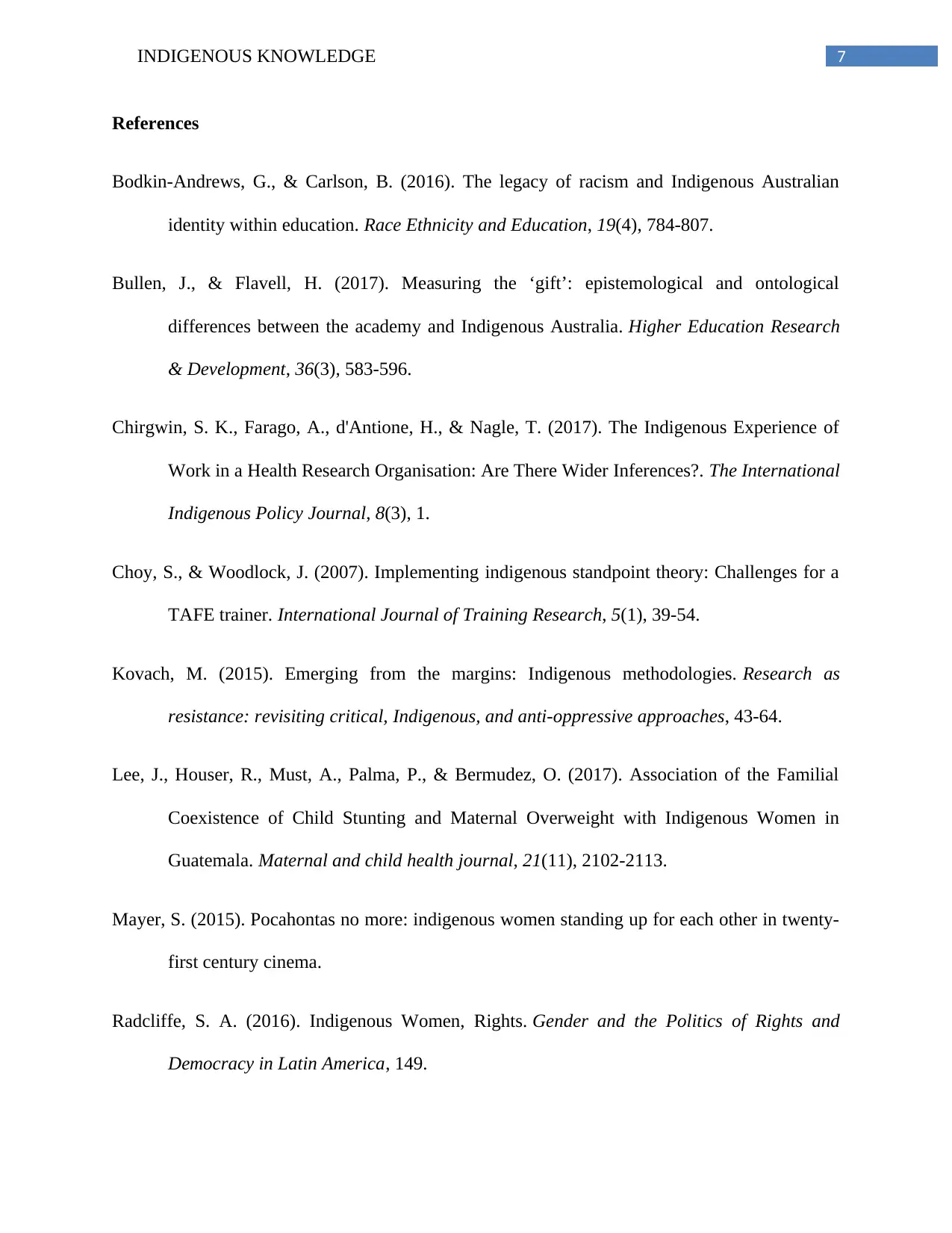
7INDIGENOUS KNOWLEDGE
References
Bodkin-Andrews, G., & Carlson, B. (2016). The legacy of racism and Indigenous Australian
identity within education. Race Ethnicity and Education, 19(4), 784-807.
Bullen, J., & Flavell, H. (2017). Measuring the ‘gift’: epistemological and ontological
differences between the academy and Indigenous Australia. Higher Education Research
& Development, 36(3), 583-596.
Chirgwin, S. K., Farago, A., d'Antione, H., & Nagle, T. (2017). The Indigenous Experience of
Work in a Health Research Organisation: Are There Wider Inferences?. The International
Indigenous Policy Journal, 8(3), 1.
Choy, S., & Woodlock, J. (2007). Implementing indigenous standpoint theory: Challenges for a
TAFE trainer. International Journal of Training Research, 5(1), 39-54.
Kovach, M. (2015). Emerging from the margins: Indigenous methodologies. Research as
resistance: revisiting critical, Indigenous, and anti-oppressive approaches, 43-64.
Lee, J., Houser, R., Must, A., Palma, P., & Bermudez, O. (2017). Association of the Familial
Coexistence of Child Stunting and Maternal Overweight with Indigenous Women in
Guatemala. Maternal and child health journal, 21(11), 2102-2113.
Mayer, S. (2015). Pocahontas no more: indigenous women standing up for each other in twenty-
first century cinema.
Radcliffe, S. A. (2016). Indigenous Women, Rights. Gender and the Politics of Rights and
Democracy in Latin America, 149.
References
Bodkin-Andrews, G., & Carlson, B. (2016). The legacy of racism and Indigenous Australian
identity within education. Race Ethnicity and Education, 19(4), 784-807.
Bullen, J., & Flavell, H. (2017). Measuring the ‘gift’: epistemological and ontological
differences between the academy and Indigenous Australia. Higher Education Research
& Development, 36(3), 583-596.
Chirgwin, S. K., Farago, A., d'Antione, H., & Nagle, T. (2017). The Indigenous Experience of
Work in a Health Research Organisation: Are There Wider Inferences?. The International
Indigenous Policy Journal, 8(3), 1.
Choy, S., & Woodlock, J. (2007). Implementing indigenous standpoint theory: Challenges for a
TAFE trainer. International Journal of Training Research, 5(1), 39-54.
Kovach, M. (2015). Emerging from the margins: Indigenous methodologies. Research as
resistance: revisiting critical, Indigenous, and anti-oppressive approaches, 43-64.
Lee, J., Houser, R., Must, A., Palma, P., & Bermudez, O. (2017). Association of the Familial
Coexistence of Child Stunting and Maternal Overweight with Indigenous Women in
Guatemala. Maternal and child health journal, 21(11), 2102-2113.
Mayer, S. (2015). Pocahontas no more: indigenous women standing up for each other in twenty-
first century cinema.
Radcliffe, S. A. (2016). Indigenous Women, Rights. Gender and the Politics of Rights and
Democracy in Latin America, 149.
Paraphrase This Document
Need a fresh take? Get an instant paraphrase of this document with our AI Paraphraser
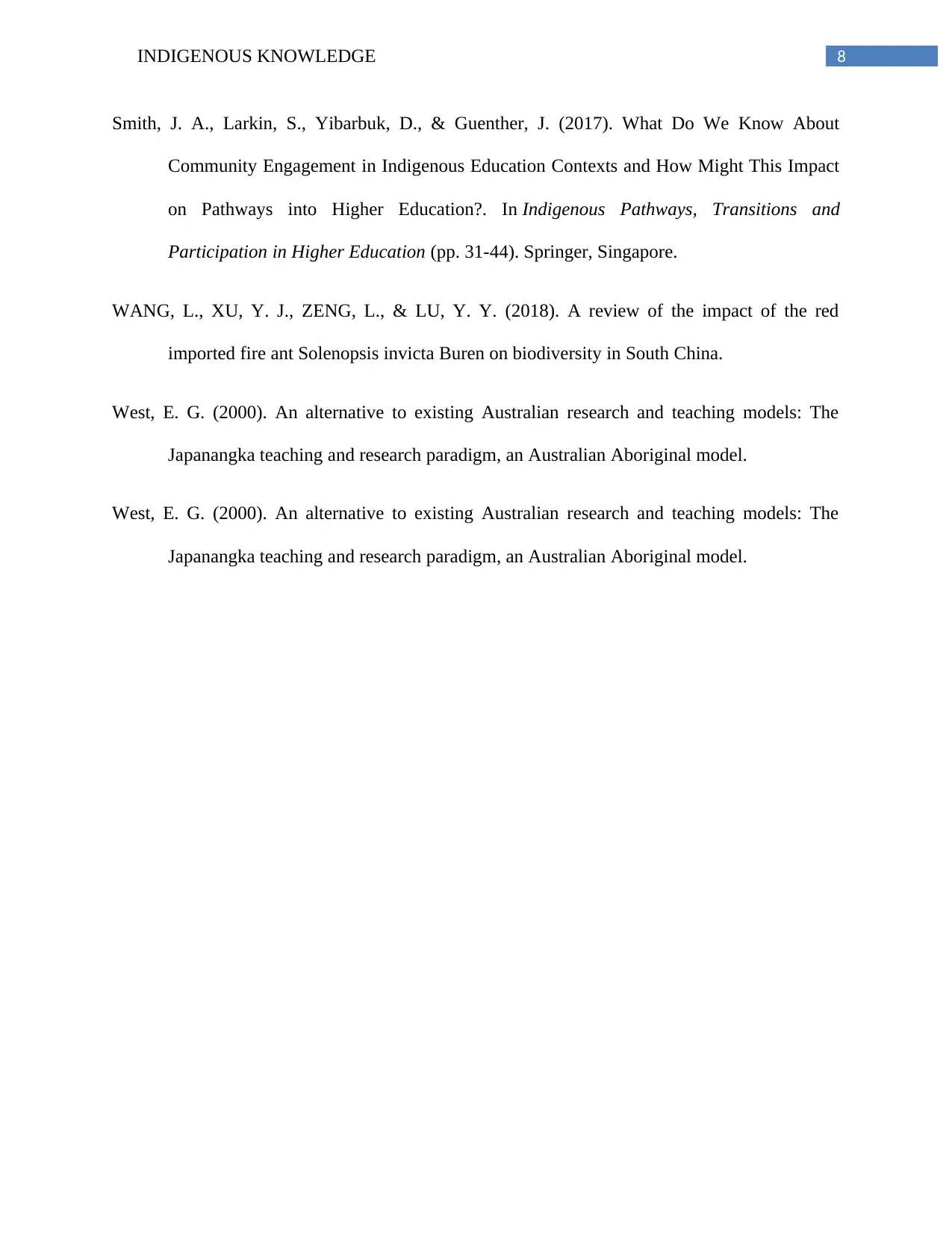
8INDIGENOUS KNOWLEDGE
Smith, J. A., Larkin, S., Yibarbuk, D., & Guenther, J. (2017). What Do We Know About
Community Engagement in Indigenous Education Contexts and How Might This Impact
on Pathways into Higher Education?. In Indigenous Pathways, Transitions and
Participation in Higher Education (pp. 31-44). Springer, Singapore.
WANG, L., XU, Y. J., ZENG, L., & LU, Y. Y. (2018). A review of the impact of the red
imported fire ant Solenopsis invicta Buren on biodiversity in South China.
West, E. G. (2000). An alternative to existing Australian research and teaching models: The
Japanangka teaching and research paradigm, an Australian Aboriginal model.
West, E. G. (2000). An alternative to existing Australian research and teaching models: The
Japanangka teaching and research paradigm, an Australian Aboriginal model.
Smith, J. A., Larkin, S., Yibarbuk, D., & Guenther, J. (2017). What Do We Know About
Community Engagement in Indigenous Education Contexts and How Might This Impact
on Pathways into Higher Education?. In Indigenous Pathways, Transitions and
Participation in Higher Education (pp. 31-44). Springer, Singapore.
WANG, L., XU, Y. J., ZENG, L., & LU, Y. Y. (2018). A review of the impact of the red
imported fire ant Solenopsis invicta Buren on biodiversity in South China.
West, E. G. (2000). An alternative to existing Australian research and teaching models: The
Japanangka teaching and research paradigm, an Australian Aboriginal model.
West, E. G. (2000). An alternative to existing Australian research and teaching models: The
Japanangka teaching and research paradigm, an Australian Aboriginal model.
1 out of 8
Related Documents
Your All-in-One AI-Powered Toolkit for Academic Success.
+13062052269
info@desklib.com
Available 24*7 on WhatsApp / Email
![[object Object]](/_next/static/media/star-bottom.7253800d.svg)
Unlock your academic potential
Copyright © 2020–2025 A2Z Services. All Rights Reserved. Developed and managed by ZUCOL.




